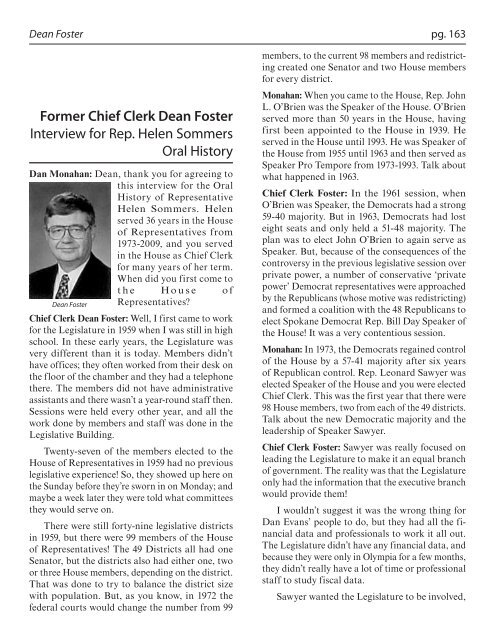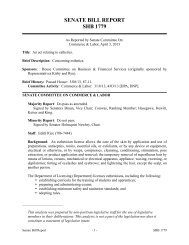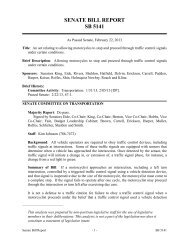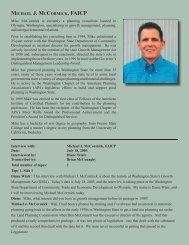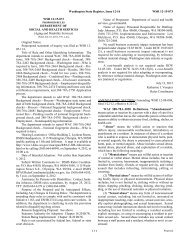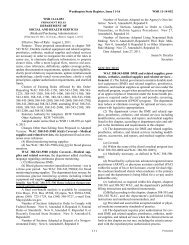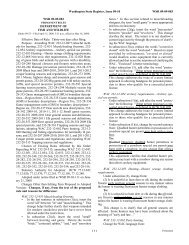Helen Sommers: An Oral History
Helen Sommers: An Oral History
Helen Sommers: An Oral History
Create successful ePaper yourself
Turn your PDF publications into a flip-book with our unique Google optimized e-Paper software.
Dean Foster<br />
Former Chief Clerk dean Foster<br />
Interview for Rep. <strong>Helen</strong> <strong>Sommers</strong><br />
<strong>Oral</strong> <strong>History</strong><br />
Dan Monahan: Dean, thank you for agreeing to<br />
this interview for the <strong>Oral</strong><br />
<strong>History</strong> of Representative<br />
<strong>Helen</strong> <strong>Sommers</strong>. <strong>Helen</strong><br />
served 36 years in the House<br />
of Representatives from<br />
1973-2009, and you served<br />
in the House as Chief Clerk<br />
for many years of her term.<br />
When did you first come to<br />
t h e Ho u s e o f<br />
Dean Foster<br />
Representatives?<br />
Chief Clerk Dean Foster: Well, I first came to work<br />
for the Legislature in 1959 when I was still in high<br />
school. In these early years, the Legislature was<br />
very different than it is today. Members didn’t<br />
have offices; they often worked from their desk on<br />
the floor of the chamber and they had a telephone<br />
there. The members did not have administrative<br />
assistants and there wasn’t a year-round staff then.<br />
Sessions were held every other year, and all the<br />
work done by members and staff was done in the<br />
Legislative Building.<br />
Twenty-seven of the members elected to the<br />
House of Representatives in 1959 had no previous<br />
legislative experience! So, they showed up here on<br />
the Sunday before they’re sworn in on Monday; and<br />
maybe a week later they were told what committees<br />
they would serve on.<br />
There were still forty-nine legislative districts<br />
in 1959, but there were 99 members of the House<br />
of Representatives! The 49 Districts all had one<br />
Senator, but the districts also had either one, two<br />
or three House members, depending on the district.<br />
That was done to try to balance the district size<br />
with population. But, as you know, in 1972 the<br />
federal courts would change the number from 99<br />
pg. 163<br />
members, to the current 98 members and redistricting<br />
created one Senator and two House members<br />
for every district.<br />
Monahan: When you came to the House, Rep. John<br />
L. O’Brien was the Speaker of the House. O’Brien<br />
served more than 50 years in the House, having<br />
first been appointed to the House in 1939. He<br />
served in the House until 1993. He was Speaker of<br />
the House from 1955 until 1963 and then served as<br />
Speaker Pro Tempore from 1973-1993. Talk about<br />
what happened in 1963.<br />
Chief Clerk Foster: In the 1961 session, when<br />
O’Brien was Speaker, the Democrats had a strong<br />
59-40 majority. But in 1963, Democrats had lost<br />
eight seats and only held a 51-48 majority. The<br />
plan was to elect John O’Brien to again serve as<br />
Speaker. But, because of the consequences of the<br />
controversy in the previous legislative session over<br />
private power, a number of conservative ‘private<br />
power’ Democrat representatives were approached<br />
by the Republicans (whose motive was redistricting)<br />
and formed a coalition with the 48 Republicans to<br />
elect Spokane Democrat Rep. Bill Day Speaker of<br />
the House! It was a very contentious session.<br />
Monahan: In 1973, the Democrats regained control<br />
of the House by a 57-41 majority after six years<br />
of Republican control. Rep. Leonard Sawyer was<br />
elected Speaker of the House and you were elected<br />
Chief Clerk. This was the first year that there were<br />
98 House members, two from each of the 49 districts.<br />
Talk about the new Democratic majority and the<br />
leadership of Speaker Sawyer.<br />
Chief Clerk Foster: Sawyer was really focused on<br />
leading the Legislature to make it an equal branch<br />
of government. The reality was that the Legislature<br />
only had the information that the executive branch<br />
would provide them!<br />
I wouldn’t suggest it was the wrong thing for<br />
Dan Evans’ people to do, but they had all the financial<br />
data and professionals to work it all out.<br />
The Legislature didn’t have any financial data, and<br />
because they were only in Olympia for a few months,<br />
they didn’t really have a lot of time or professional<br />
staff to study fiscal data.<br />
Sawyer wanted the Legislature to be involved,


